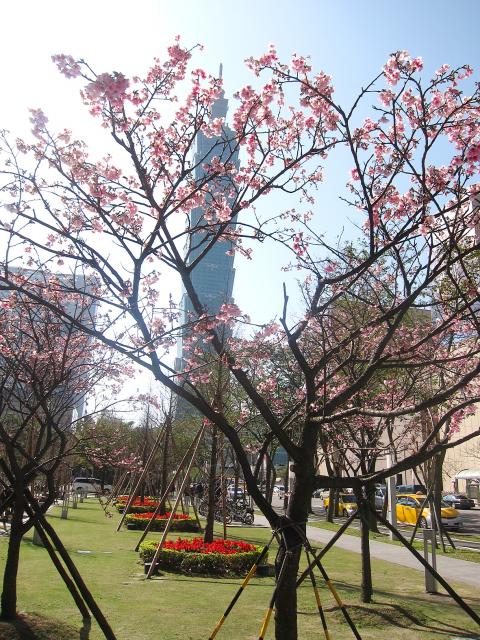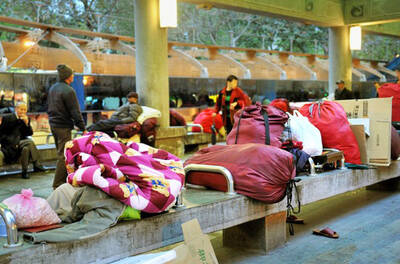Cherry blossom viewing has become a popular activity among Taiwanese, and in Taipei City the pink flowers are not only hidden in the mountains, but can now be found in downtown areas, as the Taipei City Government has planted cherry trees around the city to make blossom viewing more convenient.
With the approach of cherry blossom season in Taiwan, buds on the cherry trees at Songzhi Park in Xinyi District (信義) have begun to open, revelaing their pink petals. Located near two of the city’s main tourist attractions, Taipei 101 and the Eslite Xinyi Store, the park is one of the new locales for cherry blossom viewing in urban areas, with 12 Taiwan cherry trees lining the park, which is surrounded by high-rise office buildings.
Taipei City’s Parks and Street Light Office Secretary-General Lan Shu-fan (藍舒凡) said the city government aims to bring the city’s cherry blossoms to the attention of residents and visitors, and improve the city’s landscape.

Photo: Mo Yan-chih, Taipei Times
Taipei City Hall civil servant and Taipei resident Claire Chiu (邱宛玉) walked to the park and took photographs of cherry trees during her lunch hour on Tuesday and said seeing cherry blossoms in the commercial-centered Xinyi District was a pleasant surprise, and taking a walk in the park and enjoying the cherry blossoms has become a new way for Chiu to relieve stress.
“I was surprised when I saw the cherry blossoms in the park on my way to work. Cherry blossom spots in the mountains are grand, but I also enjoy cherry blossom viewing downtown. It feels like the cherry trees are in my backyard,” she said.
The plaza at Taipei City Hall’s north gate and another two parks in Xinyi District — Zhongquan Park and Hulin Park — also have cherry trees, Lan said.
To keep up with the trend of cherry blossom viewing, the office and Taipei City’s Department of Civil Affairs have invested more than NT$15 million (US$500,000) into the planting of more than 4,000 cherry trees in city parks and other locations since 2008.
Yongjin Park in Zhongshan District (中山) and Youth Park in Wanhua District (萬華), for example, are community parks with cherry blossom trees.
Lan said the cherry blossom season started in January and will last until March depending on weather conditions and the variety of cherry trees.
Apart from Taiwanese cherry trees, the city also planted double cherry, Japanese showa cherry and somei-yoshino cherry trees in Taipei.
Most of the cherry trees are still found in Yangmingshan (陽明山), Shilin (士林) and Beitou (北投) districts.
For people who prefer a grander viewing of the blossoms, the annual Yangmingshan Flower Festival, which will last until March 9 in Yangmingshan National Park, remains a top destination.
Yangmingshan National Park management office director Kao Min-dien (高民典) said several areas near the park — including the Chiang Kai-shek Shilin Residence, Shuangxi Park, Lin Yu-tang House, the Floriculture Experiment Center, Qianshan Park and Yangming Park — are also cherry blossom viewing spots.
Taipei City’s Geotechnical Engineering Office recommended 22 hiking trails with cherry trees along the paths.
The Yongchunliao and the White House Villa trails in Beitou District, for example, are popular cherry blossom viewing spots, it said.
Office Director Huang Li-yuan (黃立遠) suggested that visitors could hike from the villa to the Yongchunliao Trail, appreciating the view of what the locals describe as a “cherry tunnel” along the way.
The Bixi Trail in Neihu District (內湖) is another popular trail for viewing Taiwanese cherry blossoms.
In Muzha District (木柵), the Zhinan Temple Trail near the Maokong area is a cherry blossom viewing spot.
For more information on the 22 trails, please visit the Web site http://hiking.taipei.gov.tw.
Detailed information on cherry blossom viewing spots around Taipei can be found at http://flowers.taipei.gov.tw/Sakura.

Costa Rica sent a group of intelligence officials to Taiwan for a short-term training program, the first time the Central American country has done so since the countries ended official diplomatic relations in 2007, a Costa Rican media outlet reported last week. Five officials from the Costa Rican Directorate of Intelligence and Security last month spent 23 days in Taipei undergoing a series of training sessions focused on national security, La Nacion reported on Friday, quoting unnamed sources. The Costa Rican government has not confirmed the report. The Chinese embassy in Costa Rica protested the news, saying in a statement issued the same

Taiwan’s Liu Ming-i, right, who also goes by the name Ray Liu, poses with a Chinese Taipei flag after winning the gold medal in the men’s physique 170cm competition at the International Fitness and Bodybuilding Federation Asian Championship in Ajman, United Arab Emirates, yesterday.

A year-long renovation of Taipei’s Bangka Park (艋舺公園) began yesterday, as city workers fenced off the site and cleared out belongings left by homeless residents who had been living there. Despite protests from displaced residents, a city official defended the government’s relocation efforts, saying transitional housing has been offered. The renovation of the park in Taipei’s Wanhua District (萬華), near Longshan Temple (龍山寺), began at 9am yesterday, as about 20 homeless people packed their belongings and left after being asked to move by city personnel. Among them was a 90-year-old woman surnamed Wang (王), who last week said that she had no plans

TO BE APPEALED: The environment ministry said coal reduction goals had to be reached within two months, which was against the principle of legitimate expectation The Taipei High Administrative Court on Thursday ruled in favor of the Taichung Environmental Protection Bureau in its administrative litigation against the Ministry of Environment for the rescission of a NT$18 million fine (US$609,570) imposed by the bureau on the Taichung Power Plant in 2019 for alleged excess coal power generation. The bureau in November 2019 revised what it said was a “slip of the pen” in the text of the operating permit granted to the plant — which is run by Taiwan Power Co (Taipower) — in October 2017. The permit originally read: “reduce coal use by 40 percent from Jan.